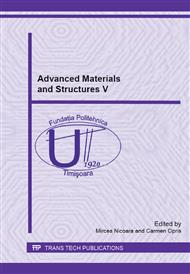p.45
p.49
p.55
p.63
p.67
p.73
p.79
p.85
p.91
Description of Degradation Process of Rubberized Lean Concrete
Abstract:
Waste tires create big problem in the world as for their utilization. One domain in which this material is able to found promising application is civil engineering. The waste tires additive in the concrete manufacturing leads to change of mechanical properties such as: Young modulus, compressive strength, fracture toughness, energy absorption, brittleness, water absorption etc. It was partly reported in the literature only for the plain concrete. There is no investigations for a lean concrete - the material which has potential applications as a subgrade of roads. The aim of this paper is to investigate the importance of the rubber particles addition in the lean concrete production as for modification of the basic mechanical properties and further degradation of the material due to mechanical loading. The new technology of compaction of the concrete was elaborated to perform basic test: cyclic uniaxial compression and cyclic bending. In order to describe gradual degradation of the rubberized lean concrete a scalar damage parameter D related to loading history was proposed. The current value of the elastic modulus was expressed as E=Eo(1-D), where Eo denotes the initial value of the Young’s modulus. The paper includes also a numerical model of the beam made of the rubberized lean concrete, which is subjected to 3-point bending deformation. The stress distribution in this beam is highly non-homogeneous with visible stress concentrations around the rubber particles.
Info:
Periodical:
Pages:
67-72
Citation:
Online since:
August 2014
Authors:
Keywords:
Price:
Сopyright:
© 2014 Trans Tech Publications Ltd. All Rights Reserved
Share:
Citation:


